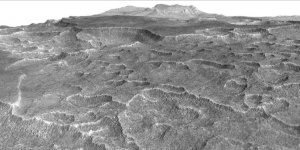| News / Space News |
NASA Finds Ancient Organic Material, Mysterious Methane on Mars
NASA's Curiosity rover has found new evidence preserved in rocks on Mars that suggests the planet could have supported ancient life, as well as new evidence in the Martian atmosphere that relates to the search for current life on the Red Planet. While not necessarily evidence of life itself, these findings are a good sign for future missions exploring the planet's surface and subsurface.

NASA's Curiosity rover has discovered ancient organic molecules on Mars, embedded within sedimentary rocks that are billions of years old. Image credit: NASA/JPL-Caltech/MSSS
"Curiosity has not determined the source of the organic molecules," said Jen Eigenbrode of NASA's Goddard Space Flight Center in Greenbelt, Maryland, who is lead author of one of the two new Science papers. "Whether it holds a record of ancient life, was food for life, or has existed in the absence of life, organic matter in Martian materials holds chemical clues to planetary conditions and processes."
Although the surface of Mars is inhospitable today, there is clear evidence that in the distant past, the Martian climate allowed liquid water - an essential ingredient for life as we know it - to pool at the surface. Data from Curiosity reveal that billions of years ago, a water lake inside Gale Crater held all the ingredients necessary for life, including chemical building blocks and energy sources.
Also, scientists describe the discovery of seasonal variation in methane in the Martian atmosphere over the course of nearly three Mars years, which is almost six Earth years. This variation was detected by Curiosity's Sample Analysis at Mars (SAM) instrument suite.
Water-rock chemistry might have generated the methane, but scientists cannot rule out the possibility of biological origins. Methane previously had been detected in Mars' atmosphere in large, unpredictable plumes. This new result shows that low levels of methane within Gale Crater repeatedly peak in warm, summer months and drop in the winter every year.
To identify organic material in the Martian soil, Curiosity drilled into sedimentary rocks known as mudstone from four areas in Gale Crater. This mudstone gradually formed billions of years ago from silt that accumulated at the bottom of the ancient lake. The rock samples were analyzed by SAM, which uses an oven to heat the samples (in excess of 900 degrees Fahrenheit, or 500 degrees Celsius) to release organic molecules from the powdered rock.
SAM measured small organic molecules that came off the mudstone sample. Some of these fragments contain sulfur, which could have helped preserve them in the same way sulfur is used to make car tires more durable.
The results also indicate organic carbon concentrations on the order of 10 parts per million or more. This is close to the amount observed in Martian meteorites and about 100 times greater than prior detections of organic carbon on Mars' surface. Some of the molecules identified include thiophenes, benzene, toluene, and small carbon chains, such as propane or butene. (NASA)
YOU MAY ALSO LIKE




